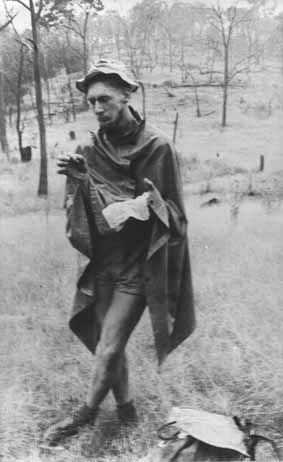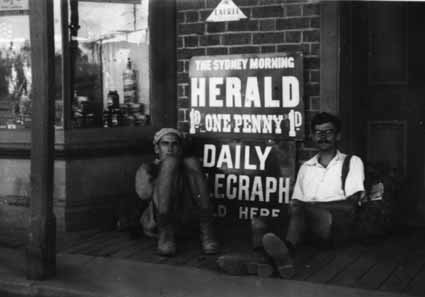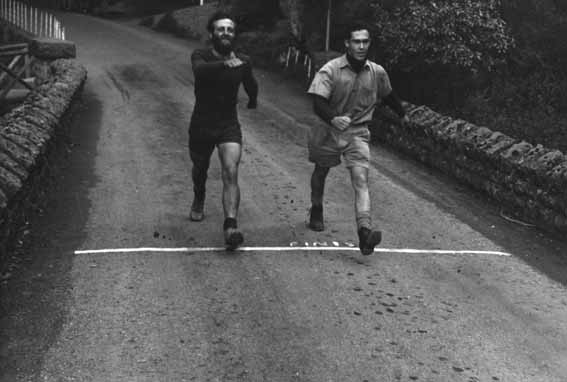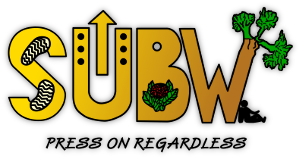A searing supplement to Ian Ross’ “Press On” article, 40th Anniversary Magazine
by Fred Doutch, first SUBW Walks Secretary, and wife Dorothy (nee Duffy)
I have to tell you that Ian’s memoir is almost totally reliable, and that what he wrote about me regrettably gives you the right impression. Everything that he said about everything gives you more or less the right impression, but I am here to make it righter. Dorothy will ensure this.
Let us not gloss over the way things were. In 1946 many of us were shocking poor. As a matter of course you would expect everybody but the new member to turn up on a walk with next to no food. Meal time was quite often belt tightening time. The finesse developed was invaluable extra-mural education. For example, here is a cleaned up version of a typical Saturday evening dinner preamble on the Cox:
Twid: – ‘I’m sure that we arranged that you should bring the chop? And unfortunately I left the potato at home’.
Fred: – ‘Well, I have only Grainut. But I wonder what the others will be persuaded into sparing…’.
The real experts, having climaxed on caffeine – see later – now practice out of Canberra.
Ian described some of the food, notably Grainut and dried mutton. We regret that Grainut went off the market before we could bring up our kids on it. What better way to fuel up for the walking day than to make a dry mix of Grainut and powdered milk, then create a soggy gritty grunge with tepid water, and ingest the slurry before it set solid. The entrepreneurial Mick Hammond would send it off with a flourish of drinking chocolate and cherry brandy. But you can’t use words about it like ‘sustaining’, Ian, without dreadfully belittling it – this was the stuff of courage and fortitude, of the conquering of the cliffs, flooded rivers and trackless jungles of the Blue Mountains – ah, the nostalgia. I don’t think any of us ever got to feeling that way about dried mutton.
And certainly not about dried potato, from which Paddy must have made a fortune. Mind you, I can only think of it with affection, although not fondness, because kind people fed it to me palatised with tea early on the fourth day of hungering down the Cox after gravitating from the Gangerangs into Ti-willa Canyon.
There are still a few timeless and fundamental necessities that we can’t imagine anyone leaving at home even now, like dried apples and apricots. Memory has them as gourmet flavours that uplifted the soul as well as the boots. Whatever is it that they make them from these days? There were other staples long since vanished. Foster Clark not only made a dried tomato soup cube that left burnt rubber aftertones, and a rather more acceptable oxtail, but also sherberty rectangular fruit flavoured sugar tablets that teased the tongue if eaten raw or got up the back of the nose if taken with water. Maybe it was also this grand old firm that created the jelly cube in various colours that could be substituted for the classic smooth pebble and stubbornly battled to counter thirst for endless track hours. Horlicks malted milk tablets were equally spine stiffening.
The greatest leap forward was Nescafe. Socially acceptable caffeine fixes anywhere in the scrub, AND a marvellous aluminium container that could hold a day’s rations for the experienced hunter-gatherer who not only counted every last oz. he carried but also counted on rewarding his forethought by relieving the burdens of others at mealtimes.
Other dubious standards, in tinned steel cans mind you, included goldfish and silverfish: herrings or pilchards in tomato sauce, and kippered snacks. I recall somewhere east of Bundanoon with Clive Prichard and, I think, Eva Rink and others a fading memory unhappily slights, inventing and enjoying a slice of pre-buttered bread topped with sardines, raspberry jam and condensed milk. That’s the sort of backbone that Grainut developed. Les Hiddens, eat your heart out!

Above – Fred Doutch near Bungonia (1948?). “He offered us all a bit of devon for lunch – as it was close to the colour of grass we relunctantly decined his offer.” Photo – Bill Woof.
Before you could expand your horizons you had to get there, and we ragged poor had no choice. Although a few could afford the 6:23pm Friday train to Katoomba, for the rest it was hitchhike or stay at home. We like to think that bushwalkers were the Kings of the Road, but we were probably a scruffy minority. Not that scruff mattered much then.
Remember, if you can (most of you haven’t a hope, and we golden oldies find it gets harder every day), that these times were just after the war. Hindsight suggests that our weekend adventuring was partly an escape from our normal environment of Art Deco and Federation houses crying out for a coat of paint, shabby shopping centres, ancient cars lately weaned from gas bags or charcoal burners, clapped out trucks, and trams and steam locos well past their use-by dates. If it did nothing else, jumping the rattler once or twice, riding the open platform of a decrepit wooden carriage in the night air of winter, on the downhill run to the city from Katoomba, sure rattled the jumper.
But we had Won the War a year back, Austerity was nearly over, and petrol rationing notwithstanding, the great hearts of the car and truck owners obligated that you really hadn’t completed your Wanderer’s Apprenticeship until you had 20,000 miles under your backside. We are really sorry that we don’t feel safe giving hitchhikers lifts now.
Ian only hints at all this. One of my vividest memories, in colour even, is of a Pigeon House trip, of overnighting in the cave at the top among the fossils, of seeing the sun rise over mist to the east, lighting the cloud filling the Clyde and the table cloth spilling over Currockbilly. To get home some of us – I’m sure Ian was one – hitched back to Sydney on a stinking fish truck, an ex-army Blitz; two were lucky and travelled in a cabin heated by an overworked motor (could that thing climb hills no it couldn’t) while I and who else jammed ourselves in between the cabin and the load of fish. It rained. In Dapto, blessed Dapto, we stopped and bought the driver a rum and raspberry. PRA, Ian, is for boys.
The sardinean walk mentioned above started with me and my pack intimately closeted with empty, clean, but very smelly black cans on the back of a night cart returning from Moss Vale to Robertson on an otherwise postcard Saturday morning, and ended Sunday dusk in a charabanc ‘service car’ from Meryla Pass to Bundanoon. Another trip with Prichard finished up with Higlett’s Yerranderie mail car which luckily for me had a trailer; richer walkers paid for their trip to Camden, I danced my way home out back on two wheels. Not recommended, and only vaguely comparable to sitting in an armchair atop a load of furniture on a ute from Tennant Creek to Mt. Isa about a year later (Alice Springs to Tennant was a freebie in a Pioneer Bus, the driver of which had been using the honeymoon suite in a Wollongong Guest House I had been staying in the year before during a choral competition. On the old steam Ghan to Alice I met two Darwin emigrants, an uncle and aunt acquired by marriage a year later; none of us had any inkling then that Prichard would be my Best Man before he too Darwinised. Try doing all that in your own car). Our honeymoon – no, I didn’t marry Prichard – was spent hitchhiking through northeastern NSW, after which I went to Macquarie Island, along with Bill Taylor and Eric Shipp, and that coincidentally was about the end of the Kings of the Road era.
As Ian said, we mastered the 1937 Blue Mountains Tourist Map. What he didn’t say was how much of it was covered in detail by Miles Dunphy’s caterpillar classics, and even now if you want to know the true, right and proper names for all the Mountains features, his maps are definitive. I think we could have dug up contoured sheets that showed the Sydney-Lithgow railway, which didn’t matter all that much. I never heard of anyone being overdue through being let down by a Dunphy map. Yes, I was overdue a couple of times, and yes, I spent fifteen undergraduate years working as a geological cartographer. Some people never learn. And it wasn’t Dunphy territory, and I firmly believe that the Blue Mountains are caterpillars left over from the Dreamtime.

Above – Alan tapsell and Mick hammond, Yerranderie, 1948. Photo – Fred Doutch.
I doubt that any of us have managed in the last fifty years to get free of the spell of the Blue Mountains. Branagan made a virtue of it, after a stumbling start when he and I separately turned into the SU Geology Department the mirror image halves of a Glossopteris rosette in a stone that I had cracked open below the far end of Narrow Neck. We got, and deserved, a right public bollocking for amateurish collecting from the lecturess in our next Palaeontology I class. Branagan never looked back, and now knows more than almost anybody else about the geology of the Blue Mountains. I had trouble looking forward, and didn’t make geologist until thirty years ago; my science is characteristically still long overdue. Having got me to the church on time, Prichard metamorphosed into a Top End Prospectors’ Friend. Dave Roots, perhaps learning from all this, can take you on Plate Tectonic safaris right now, in Siberia and South America as well as the Sydney Basin.
The Blue Mountains are far more than its rocks, of course – they are Blue Gum Forest, Arethusa Canyon, the Cox and Kowmung Rivers, Kanangra, Mt Solitary and the rest. The Sydney Basin takes in these, and also the Shoalhaven and Clyde valleys and ridges to the south, the Colo and its watersheds – including my favourite Hunter Range – and the Hunter Valley in the north. Was there ever a better wilderness area of cliffs, creeks and forests? The hell with coal, burn natural gas! Better still, Freeze On – we all know how!
It is not easy to get to know it all, and indeed developing local expertise is an excellent alternative. Roots can offer you The Pittwater Experience. Robinson has made an intensive study of the Hunter Valley and is presently a vintage guru for many of us.
For many years yet this wilderness will be turning boys into men. Surely it must be character building to camp in pitch blackness at Corral swamp in a hollow that has become a puddle by sunrise, and wake to socks and hips frozen stiff as boards. It must need a quantum leap in courage and fooishness to jump into the supercooled Cox after 20 miles of sweaty slogging knowing that severe cramps must result. And I am am here to tell you that you only drop into Ti-willa canyon from its cliff-tops once.
I never did ask Billie Harrison what the profit from blistering downhill from Solitary, five pairs of not very clean socks the better of at the bottom, followed by intermittent piggybacking up to Kings Tableland. Outcomes are better left inscrutable?
While ignorant citizens ran him out of Berrima for breaking panes of glass on their tennis courts early in the morning, Clev Slack-Royal could only benefit from experiencing just righteousness, believing that he had rid the town of life-threatening slabs of ice. Undoubtedly this more than made up for disappointment bravely borne later that day when he and Dorothy and Alan Tapsell and Jack Kelly and Mick Hammond were forbidden access to Joadja (we finally got in earlier this year). There are similar memories of abandoning a Barren Grounds trip because of heavy rain, from which much the same mob sheltered in the Berry Golf Club. The mob had now learned enterprise and self-sufficiency (on our first visit to the Barren Grounds a few years ago we drove).

Above – Clevon Slack and Peter McGregor crossing the finishing line of the 1949 Marathon at Jenolan Caves. Photo – Fred Doutch.
Both expeditions to Bendethera Caves got to see them eventually. Mine arrived a little later than scheduled, having taken a wrong creek to the west of Marulan. We travelled upstream to the south, climbed an unnamed peak, saw the coast, headed for it, walked the bed of a creek at first easterly, then to the south, then west past old alluvial workings, including a river diversion through a spur, and then north. So flows the Deua River. We were down to nettle soup and a couple of slices of mouldy bread , and such was the character building we had gone through that none of us objected when an old bushman we met cooked a damper and gave it to his dogs. He showed us the caves, which we looked at with some disinterest before heading west over the Shoalhaven watershed to Khan Yunis and its utterly unforgettable hospitality. Dorothy’s party, some months on in a Liddy truck and including Eddie Slater, Geoff Morris and Mick Hammond, also found the caves later than planned, delayed by scones and tea at Khan Yunis and no maps; on returning they were met by three horsemen who insisted on taking the ladies’ packs. Their lessons in enterprise had paid off.
Obviously character building is a very private thing. However, while earth, fire, air and water are proper to a bushwalker’s life style, so we believe is moderation, and all this talk of rain, frost and ice does us some discredit. Thankfully we can remember soul-uplifting days of sunshine that melted the frosts and showed us far horizons, some of which we achieved. We remember the joys of dropping in to Carlon’s for a three bob roast turkey feed. We remember the pleasures of the Paris Cafe at Katoomba, whose obliging owners put all bushwalkers in a back room – I believe that Dorothy and I first met there.
Done walking, many of us married and began to run. That’s been fun, too We found that Europe is a bizarre honeycomb of other peoples’ pockets that you can’t avoid living in, that North America is a mite profligate and overly dollar driven, and that our own country is rather more comfortable than the rest of the third world. Believe it or not a few of us still walk. Not me – I just stumble between the immensities…
********
Well, there you are, Ian – a bit of mapping between your lines, a few nostalgic lies of our own. And what did the Glossopteris get out of all this? Fleeting fame, that’s what. It turned up in the Australian Museum in Sydney a year or two back when Mary White, an old family friend from Somaliland Protectorate days, found it during research for her magnificent book ‘The Greening of Gondwana’. Go get a copy and become a greenie!
